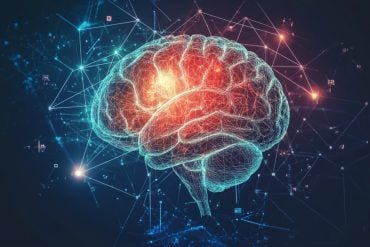Summary: Scientists have identified a group of nerve cells in the midbrain, which, when stimulated, can suspend all movement, akin to setting a film on pause.
These nerve cells, located in the pedunculopontine nucleus (PPN) and differentiated by a marker called Chx10, even affect breathing and heart rate in mice. This unique ‘pause-and-play pattern’ doesn’t seem to correlate with fear, but instead could relate to a state of alertness or focused attention.
Understanding these cells may provide insights into the motor symptoms seen in Parkinson’s disease.
Key Facts:
- Researchers have discovered a group of nerve cells in the midbrain that can halt all movement when stimulated.
- The cells, found in the pedunculopontine nucleus (PPN) and expressing the marker Chx10, impact all forms of motor activity, including breathing and heart rate.
- These cells could offer new understanding about the motor symptoms of Parkinson’s disease.
Source: University of Copenhagen
When a hunting dog picks up the scent of a deer, it sometimes freezes. On the spot. The same thing can happen to people who need to concentrate on a challenging task.
Now researchers have made a discovery that adds to our knowledge of what happens in the brain when we suddenly stop moving.
“We have found a group of nerve cells in the midbrain which, when stimulated, stop all movement. Not just walking; all forms of motor activity. They even make the mice stop breathing or breathe more slowly, and the heart rate slow down,” explains Professor Ole Kiehn, who is co-author on the study.
“There are various ways to stop movement. What is so special about these nerve cells is that once activated they cause the the movement to be paused or freeze. Just like setting a film on pause. The actors movement suddenly stop on the spot,” says Ole Kiehn.
When the researchers ended activating the nerve cells, the mice would start the movement exactly where it stopped. Just like when pressing “play” again.
“This ‘pause-and-play pattern’ is very unique; it is unlike anything we have seen before. It does not resemble other forms of movement or motor arrest we or other researchers have studied. There, the movement does not necessarily start where it stopped, but may start over with a new pattern,” says PhD Haizea Goñi-Erro, who is first author of the study.
The nerve cells stimulated by the researchers are found in the midbrain in an area called the pedunculopontine nucleus (PPN), and they differ from other nerve cells there by expressing a specific molecular marker called Chx10.
The PPN is common to all vertebrates including humans. So even though the study was performed in mice, the researchers expect the phenomenon to apply to humans too.
Not related to fear
Some might suggest that the nerve cells are activated by fear. Most people are familiar with the phenomenon of “freezing” caused by extreme fear. But that is not the case.
“We have compared this type of motor arrest to motor arrest or freezing caused by fear, and they are not identical. We are very sure that the movement arrest observe here is not related to fear. Instead, we believe it has something to do with attention or alertness, which is seen in certain situations,” says Assistant Professor Roberto Leiras, who is co-author of the study.
The researchers believe it is an expression of a focused attention. However, they stress that the study has not revealed if this is indeed the case. It is something that requires more research to demonstrate.
May be able to understand Parkinson’s symptoms.
The new study may be able to help us understand some of the mechanisms of Parkinson’s disease.
“Motor arrest or slow movement is one of the cardinal symptoms of Parkinson’s disease. We speculate that these special nerve cells in PPN are over-activated in Parkinson’s disease. That would inhibit movement.
“Therefore, the study, which primarily has focused on the fundamental mechanisms that control movement in the nervous system, may eventually help us to understand the cause of some of the motor symptoms in Parkinson’s disease,” Ole Kiehn concludes.
You can read the full study, ”Pedunculopontine Chx10+ neurons for global motor arrest in mice”, by Haizea Goñi-Erro, Raghavendra Selvan, Roberto Leiras and Ole Kiehn in Nature Neuroscience.
Funding: The study is funded by the Novo Nordisk Foundation, the Lundbeck Foundation and the Swedish Research Council.
About this neuroscience research news
Author: Liva Polack
Source: University of Copenhagen
Contact: Liva Polack – University of Copenhagen
Image: The image is credited to Neuroscience News
Original Research: Open access.
“Pedunculopontine Chx10+ neurons control global motor arrest in mice” by Ole Kiehn et al. Nature Neuroscience
Abstract
Pedunculopontine Chx10+ neurons control global motor arrest in mice
Arrest of ongoing movements is an integral part of executing motor programs. Behavioral arrest may happen upon termination of a variety of goal-directed movements or as a global motor arrest either in the context of fear or in response to salient environmental cues. The neuronal circuits that bridge with the executive motor circuits to implement a global motor arrest are poorly understood.
We report the discovery that the activation of glutamatergic Chx10-derived neurons in the pedunculopontine nucleus (PPN) in mice arrests all ongoing movements while simultaneously causing apnea and bradycardia. This global motor arrest has a pause-and-play pattern with an instantaneous interruption of movement followed by a short-latency continuation from where it was paused.
Mice naturally perform arrest bouts with the same combination of motor and autonomic features. The Chx10-PPN-evoked arrest is different to ventrolateral periaqueductal gray-induced freezing.
Our study defines a motor command that induces a global motor arrest, which may be recruited in response to salient environmental cues to allow for a preparatory or arousal state, and identifies a locomotor-opposing role for rostrally biased glutamatergic neurons in the PPN.







